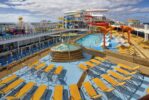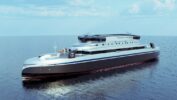easyJet delivers robust performance, demonstrating strong cost control with enhanced network position and customer proposition in the year ending 30 september 2017.Â

Summary
Investing in number one and number two positions
·     Record number of passengers at 80.2 million, up 9.7% year on year, with record load factor at 92.6% (2016: 91.6%), reflecting easyJet’s strong network positions and customer proposition
·     Capacity grew by 8.5% to over 86.7 million seats, as easyJet continued its strategy of purposeful investment with a focus on number one and two market positions at Europe’s leading airports
·     Total revenue of £5,047 million, up 8.1%, with revenue per seat broadly flat year on year      (-0.4%) at £58.23, reflecting a currency benefit, strong ancillary revenue¹ and increased load factors, alleviating ticket pricing pressures
·     98% of easyJet capacity touches a number one or number two airport
Rigorous cost control
·     Strong cost control, driven by increasing benefits of scale and stronger network positions, along with Lean savings of £85 million offsetting inflationary pressure in the market
·     Headline cost per seat excluding fuel at constant currency² increased by 0.9% to £38.69, in line with guidance, with the investment in resilience representing an increase of 0.7% of that increase, as well as the impact of continued high levels of disruption. Headline cost per seat at constant currency decreased by 4.4% to £49.96 due to the benefit of a lower hedged fuel price. Headline cost per seat increased 2.4% to £53.52 mainly as a result of negative currency effects
·     Financial year 2017 headline cost per seat, excluding fuel and disruption, at constant currency is marginally lower than 2015 financial year
Resilient business model
·     Headline profit before tax of £408 million, demonstrating the resilience of easyJet’s business model, despite an adverse headline currency impact of £101 million
·     Business model underpinned by strong balance sheet and net cash position of £357 million, with industry leading credit ratings from S&P and Moody’s
·     Reported profit before tax of £385 million, after non-headline costs of £23 million mainly relating to sale and leaseback charges
·     Dividend proposed of 40.9 pence per share, in line with the Company’s increased payout policy of 50% of headline profit after tax. The dividend is expected to be paid on 23 March 2018, with a record date on 2 March 2018, subject to shareholder approval at the Annual General Meeting.
Air Berlin acquisition
·     In October easyJet announced an agreement to acquire part of Air Berlin’s operations at Berlin Tegel airport for a purchase consideration of €40 million, subject to antitrust and regulatory approvals. The acquisition, which is expected to close in December 2017, will result in easyjet entering into leases for up to 25 A320 aircraft, offering employment to up to 1,000 former Air Berlin crews and taking over other assets including slots. The purchase price excludes start-up and transitional operating costs
·     Alongside its existing base at Berlin Schönefeld this will establish easyJet as the leading short-haul airline in Berlin
·     Based on current assumptions, easyJet expects to incur headline losses of around £60 million on its activities at Tegel in 2018 financial year, as it starts up operations in January 2018 using wet lease aircraft with initially lower loads and yields. In addition, one-off non-headline costs associated with the transaction are expected in the 2018 financial year of around £100 million. These costs represent the parallel ramp up of a dry lease operation, including fleet conversion and staff recruitment and training costs, as well as transaction costs
·     The transaction is expected to be earnings accretive by 2019 financial year
Outlook
·     easyJet will continue its strategy of purposeful investment to drive profitable growth to secure leading positions at primary airports, increasing returns over the long-term. easyJet plans to grow capacity by around 6% for the 2018 financial year, excluding any prospective Air Berlin capacity
·     Forward bookings are ahead of last year at 88% for the first quarter and 26% for the second quarter
·     Revenue trends in the first quarter have been encouraging, primarily as a result of some capacity leaving the market. Revenue per seat growth at constant currency in the first quarter is now expected to be positive by low to mid-single digits and reflects a degree of short-term benefit as well as underlying improvement. Revenue per seat growth at constant currency in the first half is also currently expected to be positive by low to mid-single digits including the move of Easter from the third quarter, excluding the impact of Air Berlin. Visibility for the second half of the financial year is very limited.
·     Total headline cost per seat is expected to decrease by around 2% during the 12 months to 30 September 2018, excluding Air Berlin. Headline cost per seat excluding fuel and at constant currency (excluding Air Berlin) is expected to increase by up to 1% principally due to crew and ground handling cost inflation. Before the impact of acquisitions, easyJet remains on target to achieve its flat headline cost per seat target excluding fuel and at constant currency in 2019 vs 2015, assuming normal levels of disruption
·     easyJet’s policy of paying its dividend from headline profit after tax is expected to deliver dividend growth in 2018 financial year
On 10 November 2017 the Board announced the appointment of Johan Lundgren as its new CEO as replacement to Carolyn McCall. Johan was previously Group Deputy Chief Executive Officer of TUI Group. He will be joining the Company on 1 December 2017, with Carolyn stepping down on 30 November.
|
  |
2017 |
2016 (restated*) |
Change |
||
|
Total revenue (£ million) |
5,047 |
4,669 |
8.1% |
||
|
Headline profit before tax (£ million) |
408 |
494 |
(17.3%) |
||
|
Headline pre-tax margin (%) |
8.1 |
10.6 |
-2.5ppts |
||
|
Headline basic earnings per share (pence) |
82.5 |
108.4 |
(23.9%) |
||
|
Proposed ordinary dividend per share (pence) |
40.9 |
53.8 |
(24.0%) |
||
|
Total profit after tax (£ million) |
305 |
437 |
(30.2%) |
||
|
Total basic earnings per share (pence) |
77.4 |
110.9 |
(30.2%) |
||
|
Headline return on capital employed (%) |
11.9 |
15.0 |
-3.1ppts |
||
* see note 1 to the accounts
Commenting on the results, Carolyn McCall, easyJet Chief Executive said:
– easyJet delivered a robust performance during a difficult year for the aviation industry, flying a record 80 million passengers at our highest ever annual load factor of 92.6% whilst growing capacity by 8.5% and revenues by over 8.1% to more than £5 billion.
– Our planned approach of achieving number one or two positions at Europe’s leading airports, friendly and efficient customer service and a continuous focus on sustainable cost control has put easyJet at a strategic advantage during a period when there have been bankruptcies and some airlines have struggled operationally.  easyJet’s model is resilient and sustainable and we now have a huge amount of positive momentum which will enable the airline to continue to grow profitably.
– On a personal note, this will be my final set of results as CEO and I would like to thank all of easyJet’s people who have contributed so much to easyJet’s success story. I wish them all the very best for the future.”





